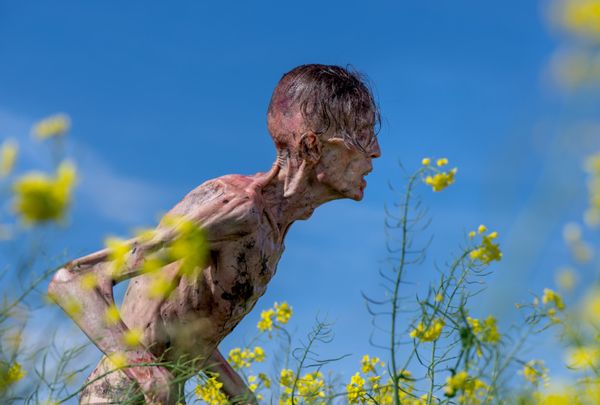In 2003, Danny Boyle’s revolutionary zombie movie “28 Days Later” introduced the world to the Rage virus, a bloodborne pathogen that infects its host in seconds and turns them into a raving, vicious, homicidal member of the walking dead. Once contaminated, a host loses their soul and forgets their humanity. Every memory of their existence prior is wiped; the infected know only anger and a visceral lust for carnage. Sound familiar?
Even if you’ve never seen the film, or its 2007 sequel, “28 Weeks Later,” those symptoms may ring with an eerie resonance. Whether it’s walking out your door to grab some milk, turning on the news, or cycling back to the same social media app we know will bring us nothing but strife, our modern variant of the Rage virus confronts us at every turn. The fury isn’t just quickly spreading, it’s already here, as unavoidable and contagious as zombiefied wrath in Boyle’s film — just with less frequent hemorrhaging. (Though, our contemporary version is liable to wreak some havoc on a blood vessel or two.) “28 Days Later” was a zombie movie that bucked the subgenre’s conventions. It prioritized style and emotion, favoring ghostly digital video production and uniquely complicated, human characters over jump scares and predictable gore. Boyle aimed to scare, yes, but also to create a world that looked so much like ours that it would feel all the more sinister to the viewer. Often, when tragedy strikes, everything around us looks exactly the same; it’s the feeling that has changed forever, and in this case, all it took was four weeks.

Boyle’s experimental filmmaking bolsters some of that missing tension, but “28 Years Later” still feels too similar to the ways we try to quarantine ourselves from violence and rage daily, becoming an experience that skews more sadly redundant than terrifying.
In this franchise, the rapidity of change runs parallel to the infestation of anger. Both move at the same pace, possessing the same certainty, and that’s precisely why the highly anticipated third film in the series, “28 Years Later,” is both horrifying and not very scary at all. What once seemed apocalyptic now looks just left of reality, a fact that Boyle — returning to the series after sitting out the sequel — and screenwriter Alex Garland are keenly aware of, yet not entirely sure how to wrestle with. Their funhouse mirror looks less distorted than ever, showing the audience a reflection that is still grisly and depressing but no longer so difficult to look at. Boyle’s experimental filmmaking bolsters some of that missing tension, but “28 Years Later” still feels too similar to the ways we try to quarantine ourselves from violence and rage daily, becoming an experience that skews more sadly redundant than terrifying.
Like its title suggests, “28 Years Later” takes place nearly three decades after the initial outbreak of the Rage virus. What was once Great Britain is now a quarantined island, cut off from the mainland and protected by an armed causeway that can only be accessed during low tide. There, Jamie (Aaron Taylor-Johnson) and his son Spike (Alfie Williams) and wife Isla (Jodie Comer) live in semi-peace, along with a swath of others who have reverted to a largely analog existence. There are no phones (lucky!), no radio, and the uncontaminated society works together to provide schooling, social lives and extremely rudimentary medicine, which has left Isla suffering from an illness that can’t be properly diagnosed. When Spike turns 12, Jamie takes him to the mainland, where the infected roam freely — some gluttonous and crawling; others fast-moving and strong — to learn how to hunt and gather to provide for the island. This is, of course, where things start to go wrong.
Their brief mission extends to an overnight stay on the mainland when Jamie and Spike are discovered by a group of Alphas — zombies of the sprinting, ravenous and homicidal kind. Though Spike gets a few solid practice kills in on the slow-moving undead, his nerves get the best of him when it comes to the Alphas, wasting arrows that do little more than maim. The father and son team manage to successfully escape and hide, biding their time until the tide is low and they can sneak home. But what Jamie doesn’t know is that Spike’s crash course in modern living has already instilled a misplaced confidence in his son, encouraging his precociousness when they do finally make it back home. The duo only made a narrow escape, running from an Alpha in a heart-pounding chase sequence that boasts breathtaking experimental camerawork from Boyle. But as fearful as he is, Spike is undaunted. And when Isla starts to exhibit increasing signs of decline, Spike flees with his mother to the mainland to seek help from Dr. Kelson (Ralph Fiennes), a holdover whose decision to stay on the mainland led the uninfected to prattle rumors of his insanity.

No matter which side of the increasingly dissonant political divide we sit on, rage emanates from either end. Often, it seems like there is no coming back, no antidote to procure and no way to heal this virus. It’s too fast-acting, too infectious; the only difference is that, for us, the rage is disseminated through X and TikTok, the same places we inevitably proliferate the sickness to everyone else.
The problem with dipping your toe into the dark pool of uninhibited rage is that its roiling waters are both horrific and fascinating. For all the viewer knows, Spike has never seen the true scope of the Rage virus, never experienced the extent of its victims’ wrath. To him, it’s almost like a video game — something he’s never heard of himself, given that most people probably forgot all about the joys of the PlayStation 2 the moment the virus hit — where violence is manageable and even a little satisfying. Spike’s curiosity is merely a latent part of his human nature, dredged up by the cyclone of adrenaline that comes with surviving near-death and wanting to experience that rush all over again.
But anger is a nasty drug, as mutant and deceptive as any virus. Garland’s script touches on the ways anger turns into violent resentment more heavily in the film’s epilogue (which clunkily lands after a big would-be, here-come-the-credits ending), but in “28 Years Later” — the first film in a planned sequel trilogy — he’s only just starting to assess its effects. Spike is being fundamentally altered before the viewers’ eyes with every bit of brutality he witnesses or commits, and even small moments of hope found along the way aren’t enough to overpower the darkness. That’s true both for real life and for Garland’s screenplay, which is propped up significantly by Boyle’s stylistic prowess. Boyle’s directorial decisions and clever, mesmerizing editing are largely why the film can outrun its zombie genre conventions. But, whether intentional or not (and given his penchant for commentary, I’d guess intentional), Garland does ask some disarmingly honest questions about how we can protect our sanity and find joy in unrelenting bleakness.
Those uninfected by the virus are quarantined to preserve their sound minds. Their heads are level. They experience sadness and exasperation, but not rage. But it’s only half of a life, uninformed by the reality of what sits beyond the walls of their haven. As Garland unexpectedly reveals in the second act, there is a world that stretches far beyond what used to be Great Britain, one that looks suspiciously close to what we know today. While this moment lends a great bit of comedic relief, it’s also a blistering look at how something that was once irrefutably a horror movie dystopia is not so different from the world we currently inhabit. No matter which side of the increasingly dissonant political divide we sit on, rage emanates from either end. Often, it seems like there is no coming back, no antidote to procure and no way to heal this virus. It’s too fast-acting, too infectious; the only difference is that, for us, the rage is disseminated through X and TikTok, the same places we inevitably proliferate the sickness to everyone else.
Quarantining ourselves isn’t a complete fix, just a temporary solution. But living steeped in rage will kill our souls even faster, turning us into zombies who do little more than crawl around, looking for the next piece of clickbait to feast on so we can spread our virus. “28 Years Later” offers no big, sweeping fix because, sadly, there isn’t one. And there are only so many disembowelings and spine-rippings that one can endure before their sense of fear is dulled. Destruction, chaos and hatred are such familiar sights that they no longer contain the same amount of terror. And while Boyle’s unmissable visual style is reason enough to catch “28 Years Later” in a theater, it’s far from an earth-shattering experience. Everything afterward will be the same: the pulsing summer sun, people shouting at each other on the street and a bunch of push notifications with bad news. Maybe quarantine isn’t such a bad solution after all.











